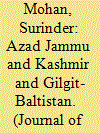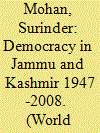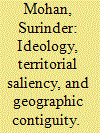| Srl | Item |
| 1 |
ID:
096053


|
|
|
| 2 |
ID:
118870


|
|
|
| 3 |
ID:
147571


|
|
|
|
|
| Summary/Abstract |
Most explanations tend to claim that ‘ideology’ played single most important role in initiating the Indo-Pakistani rivalry. This study argues that Kashmir’s territorial saliency and proximity with the challenger state, Pakistan, also played fundamental role to begin this rivalry. By adopting a conceptual framework underpinned by the conception of enduring rivalry, this article shows how the fusion of ideology, territorial saliency, and geographic contiguity formed a stronger core which influenced external strategic factors and collectively formulated a ‘hub-and-spokes’ framework to move the cartwheel of India–Pakistan rivalry. Placed within this framework, once India and Pakistan’s bilateral conflict over Kashmir had taken roots, ever-increasing interaction between ‘hub’ and ‘spokes’ brought in centripetal and centrifugal stress on the embryonic rivalry by unfolding a process of change, that is, the gradual augmentation in hostility and accumulation of grievances, which locked them into a longstanding rivalry.
|
|
|
|
|
|
|
|
|
|
|
|
|
|
|
|
| 4 |
ID:
181700


|
|
|
|
|
| Summary/Abstract |
In this paper, we argue that China is seeking to establish a balance of power favourable to its interests in South Asia and the adjoining waters to curtail India’s rise. Military balancing, economic engagement, and the new multi-regional connectivity project – the “Belt and Road Initiative” – are the key components of China’s policy against India. By roping in the South Asian and the Indian Ocean states, China has effectively deployed the “string of pearls” strategy with an express purpose to box-in India within the region so that it cannot challenge China’s primacy in Asia and beyond. To neutralise Beijing’s assertive activities, New Delhi has evolved its Asia policy with a clear motive to enhance its ties with the key Indo-Pacific states – the US, Japan, Australia, and the Southeast Asian countries – so that it could develop counter-leverages against China and simultaneously manage its rise as a major Indo-Pacific power. Given that both India and China are vying for similar power position in the same region, it is highly likely that their clashing interests might intensify their power competition in the near future.
|
|
|
|
|
|
|
|
|
|
|
|
|
|
|
|